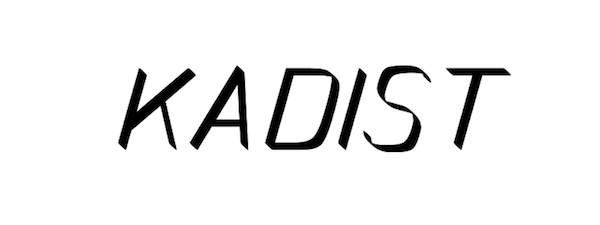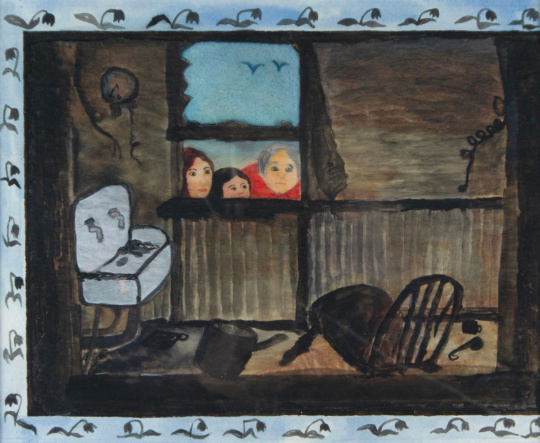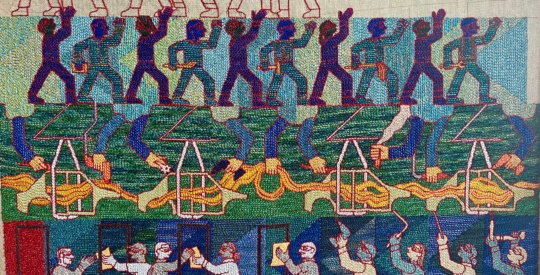On Thursday, March 4th at the invitation of KADIST in San Francisco, I led a roundtable discussion between three of my favorite artists working in the state of Georgia: Suzanne Jackson, Yanique Norman, and Katya Tepper. All three share an approach to art-making that is deeply engaged with references to art history, their personal experiences, and the poetic recasting of everyday objects and images. But they all also work in a way that is materially generous and maximal, each artist has engineered a hybrid approach to collage, painting, and sculpture unique to their respective practices. We spoke live over Zoom, a recording of which is available below along with a written version of the conversation that has been edited for publication.
Georgia Dispatch from KADIST on Vimeo.
Erin Jane Nelson: Suzanne, one of the recent articles about your work talked about this funny reversal in your career trajectory. Where many artists in your generation, especially women, have seemed to just now getting long overdue recognition for work they made decades ago, you are very actively making some of the best and most ambitious work of your life at this moment and are also getting much overdue attention. As an artist we are often thinking we have to follow this traditional career path. We go to graduate school and keep building a body of work after body of work and I think your story is really interesting because you make the pivots from gallerist to dancer to set designer and back to art again. I was wondering if you could talk a little bit about those circuitous paths. I know particularly our San Francisco audience will also be interested in hearing about your time in the Bay Area.
Suzanne Jackson: It’s quite fascinating to me because people think that I’ve switched back and forth. I’ve never considered myself a gallerist. I have been an artist who within my community of artists because we are not mainstream, we were not considered mainstream, we simply worked together to put exhibitions together. I have always been a painter since I was a baby. I never stopped. When I was a dancer, I was also a painter. When I paint, I write poetry, I move. I live and eat and it’s all the same to me. That the whole idea of “art is life, life is art” has been very important to me and it’s a part of who I am. I was born in the middle of the United States in Saint Louis, and my parents moved before I was a year old to San Francisco—so I saw art works and beauty in San Francisco first. Then, we moved to Alaska where I grew up in the magnificence of nature, which has overwhelmingly been part of my life and still is.
In my generation we did not expect to get an MFA. We expected that we would finish our liberal arts education or get no education at all. I was basically self-taught. Even going to college, we were in a period of time that was pretty independent. We were working with each other, helping each other out if we made big canvases. Our professors came in the beginning, middle, and end of the year. When I left college, I auditioned and ended up on tour in South America and ended up in Los Angeles and took the class with Charles White. He was only the second Black instructor I ever had in my studies. In a sense he was a mentor. But there were also mentors like Dr. Samella Lewis and Elizabeth Catlett who sort of mentored us along the way in Los Angeles, all of us as artists. I just didn’t know any better. I didn’t know they separated people into color or women artists. I just knew I was going to be an artist.
I have been persistent and determined with everything I do. So, moving from place to place I now realize I have been following the paths of ancestors and since I’ve moved to Georgia I have learned more about my history, who I am. I would never expect to be in Georgia at all and here I am with my final fifteenth studio space which I love.
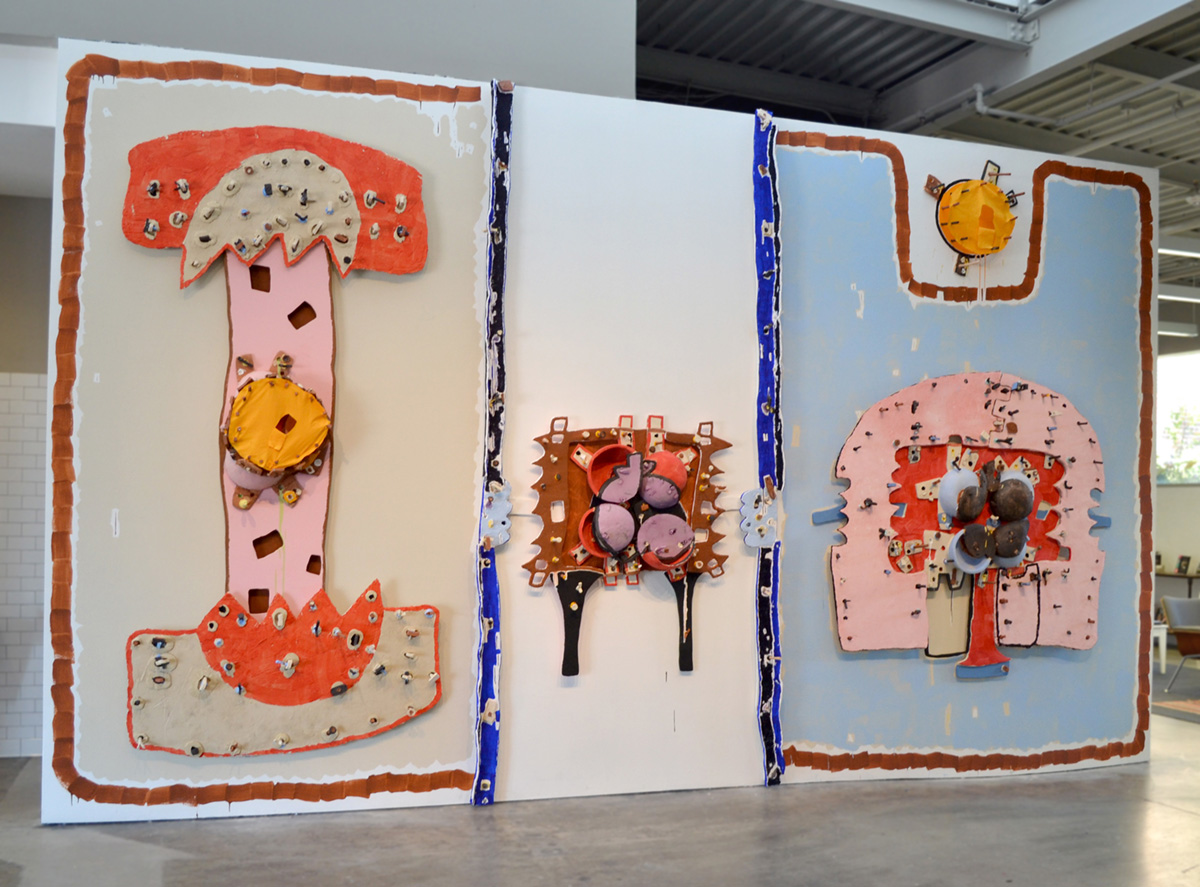
Erin: My next question is for Katya. One of things I love about your work is whenever you talk about it you talk about it in this unflinching way you dive into personal topics and yet your work reads as quite abstract and sort of materially driven. I’m wondering how you square the way you are making work with conversation around illness and queerness of your personal history.
Katya Tepper: I’ll start with the queerness thing because that’s kind of a nice story. I was making work that was really queer way before I realized I was, so in that sense, making a material abstract studio-based practice was just helpful in a certain self-discovery. A solid example is I was using plungers. I made a sculpture that had twenty something plungers in it and I was thinking of them for their connotations with plumbing and plumbing as infrastructure, but I was also using them in this kind of psychosexual way where the phallic element was really exaggerated but also the breast-like element. I was thinking of it as an interchangeable, fluid gender signifier and then a few months later I was oh, I’m nonbinary, duh! So that was a nice moment of the art serving the life.
With the way I’ve had public engagement around disability I would say it’s mostly so that when other disabled or chronically ill people are viewing my work, they know I’m not just stylizing the paraphernalia of illness because I think it’s cool or shocking. If you’ve ever had to take medical enemas you know it’s a real hurdle to get your insurance cover and it’s not just shock value material. I wanted to make sure my audience knows I’m not just trying to milk something for an aesthetic instead of for a politic. The abstraction in the work really came also before I had language around something that was hard to talk about or that nothing in my life had given me enough tools to talk about it until I found community. Over the last few years, my chronic illness is a process of constant change and the rupture that I think everyone is experiencing with the pandemic—because of illness—it is constantly unfolding part of chronic illness. So, I change a lot and my work changes a lot so there’s always a new paradigm. Now I’m not making abstract or material work. I have a seventy-page manuscript in progress right now so I would say this is in a way dealing a lot more directly with the themes described but also still very maximal list in content. It’s not abstract but it’s highly fragmented.
Erin: Yanique, the next question is for you. Your collages are centered around core found photographs. Could you give a little bit of background where you are finding your imagery and talk about if you ever made photographs as part of your work.
Yanique Norman: I have a little bit of a long story about my work. I was mostly known for my surrealist drawings before working at the Georgia Instructional Materials Center (GIMC), a unit within the GaDOE’s division for Special Education Services and Supports, which provides accessible educational materials for differently abled students. In my job we rely heavily on prison labor to produce braille and large-print textbooks. Being part of that kind of environment, I didn’t realize at the time how it affected me so much. After working on the job for a few years, my managers commissioned me to make portraits of inmates so as to rehabilitate the goodwill of state-run IMC programs like ours. Here, I wanted to really capture their inner psychology, but unable to carry a camera in a prison, I was forced to commit images to memory and what have you, and in going through that kind of experience, I ended up incorporating mugshots as part of my drawing practice.
In 2017 I was able to collect about 500 mugshots from various Georgia prison databases at one time. I have since then been using that same archive for all of my images to date. While I used these mug shots as a way to warm up to my drawing process, it was also towards the end of the Obama presidency and the beginning of Trump. At the time, I was already trying to deconstruct and unravel my drawing to understand the aesthetics of power. These photographs were an immediate way to handle these sorts of complex ideas about the institution, about what power is. And during that time, there were these other public conversations about the impact and legacy of Michelle Obama that I was also wrestling with. Working in the studio, things often collide. In this instance, I was collecting archival images of first ladies and one day a mugshot ended up on top of a First Lady, and I thought the juxtaposition was really interesting and that was the beginning of me delving deeply into collage.
Erin: One of the first things I think about with all of your work is the really unique places you make it. I have seen all of your studio buildings and homes, and it seems to me that a lot of artists in Georgia are working in less traditional industrial type artist studios. So, I was wondering if you could talk about your workspace and if it feels different from where you used to live?
Suzanne: I mentioned this is my fifteenth studio. The building I’m in now I found because I was helping someone else find a space. It’s a three-story building with about eighteen huge rooms and my studio is on the first floor. And like a chain of beads on a necklace, rooms move from the front to the back, but I have space upstairs on the second and third floor. I’m also restoring this building. My work feeds from the pieces of restoration that are left over. I can’t throw things away. I don’t want to put things into the environment. I let leftover paint dry and put it back into the work. I’m always saving pieces and parts from this building which has made my work not only painting but sculpture at the same time. When I moved to Savannah, I thought I would be working figuratively. But my work changed because of light and space and history and culture. It’s culture shock when you move from the west to the south. It’s amazing. The history now especially is phenomenal to me here in Georgia.
Yanique: My studio is actually a church. It was built in 1929 and the offices of the clergy are converted into artist studios. The thing that is most interesting about my space is the acoustics. Since it’s a church, the sound is really amazing. At the time when I moved in, there was an actual church worshipping there and on Sundays you could hear them singing through the walls, which again was incredibly amazing. In addition to this, we also have musicians as our other studio tenants. In the beginning, there was a lot of tension between the musicians and visual artists as we tried our best to negotiate the appropriate times for rehearsals & suitable times for uninterrupted quiet as the acoustics wherever you were in the building, though really beautiful, those echoes can reverberate through the ceilings, walls and floors. Being that this was my second professional studio space, I relished being in a big and spacious space. I would make these collages so big that I had to build them in sections so as to fit comfortably into the space. Filling a space that’s really large surely impacts the work so much so that my work has now become very interested in sound. For the Atlanta Biennial, I experimented with sound by creating a dense sonic environment where I was collaging different sounds on top of each other. So I guess my space is also part of the “being fungible;” it’s very responsive and sensitive to its environment and now that I’m thinking about it, the work is literally responding to where I am in an unconscious kind of way.
Katya: I haven’t lived in a big city since I was 22, so 11 or 12 years. My work has lot to do with landscape and non-urban spaces. My studio, well, I would say it’s been highly domestic and that has had lot to do with disability and illness, even when I was making monumentally scale work a lot of it was made in modular pieces that I was sewing by hand on the couch, reclining. And doing that a lot to make my twelve-foot sculptures.
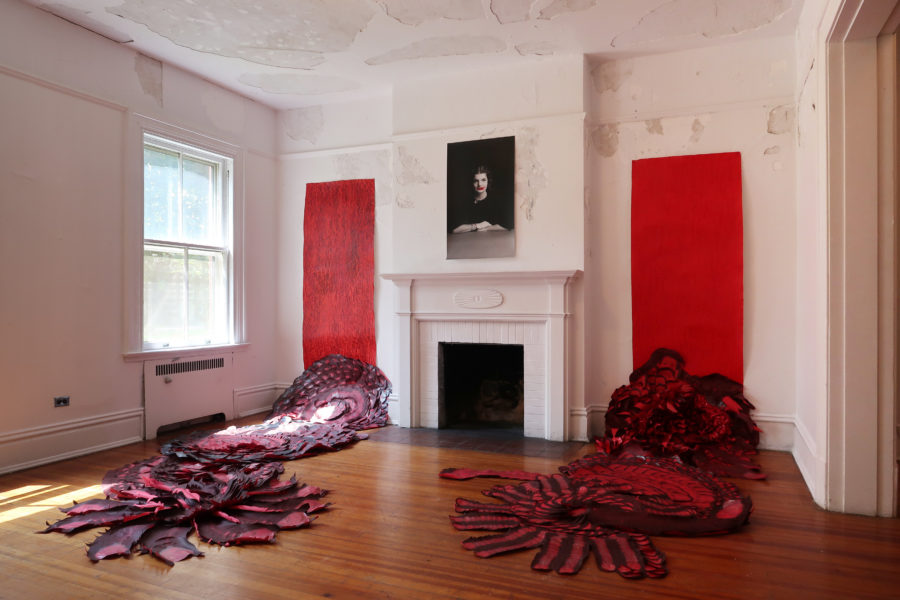
Erin: So, I’m going to ask one more question and then we’ll open up for audience questions. My experience of living in Atlanta has always required building communities that extend beyond other artists of my age and in the immediate vicinity. This feels different than peers of mine who are in bigger arts centers with huge arts communities. I was wondering to what degree you have built alternative systems of community within your city. The first thing that came to mind was Suzanne, you are involved with a jazz radio show in Savannah.
Suzanne: Actually, we call it African American classical music, also known as jazz. Because jazz is “not a nice word”. But it’s blues and what’s fascinating here is that so many of us artists of my generation have been influenced by it. We cannot work without the music. Spiritually, culturally, it’s within us and it comes along with the work. I was teaching and the students surprised me because they were listening to the music of their grandparents, so many people were influenced by this American Music, Rhythm and Blues, listening to Coltrane, Miles Davis.
Here in Savannah some of the students who graduated are still in the community. Some of the students have more gray hair than I have, because they’ve been here for a long time, supporting each other. The radio show overlaps with life in the city and activities that happen in the community. People think and create by listening to the radio and music. That spiritual essence feeds us all here. Even listening to the sounds from outside, the birds, even the wind, really influences my work and everything I do. Every place I’ve lived, it’s about listening and even the silence. Our music group hasn’t met since COVID, but we have been replaying programs from 2013 and it and they’re always fresh. It’s amazing to me. Music is an essence that keeps us going, all kinds of music is very important for our spiritual nature. It’s the sound we came in with and we’ll go out with it too.
Katya: I would say that I’ve had two different kinds of community. One has existed in this kind of remote space way proceeding the pandemic, where I have been networked with other people working through disability justice and illness and even people that lived in the same city still using Zoom as a way to make things accessible. In terms of really finding my people in Athens, that’s happened more in organizing spaces for the most part. I am really excited about what my friend and fellow Burnaway contributor, Mo Costello, is cooking up here that would involve a kind of project space in the Georgia flea market which is a trip if you have ever been there. I think what they are thinking through seems really interesting to me because it’s really site-specific and I think there’s a tendency for art groups outside of big cities to make Instagram geared spaces. I’m really invested in doing things in Athens that are not for other places, or that are at least Georgia specific.
Yanique: For me, I’ve always had networks outside of Atlanta, coming from SAIC [School of the Art Institute of Chicago] I still connect with that community in terms of my colleagues. However, since the pandemic, I’ve committed to being part of “fake communities” or remote communities. It’s not personally for me per se but for the work itself. For example, I subscribe to the Metropolitan Opera so as to better understand the intricacies of sound, costuming and elaborate stagecraft as I’m investigating that more and more within the work. I’ve also subscribed to tons of YouTube channels, especially those that pander to Black women who are talking about femininity in a both lighthearted way but also in a deep kind of way too, because again I’m investigating the institution of femininity and all the cultural polemics surrounding it. In addition, I have been attending a lot of Zoom artist talks. And I think this mixture of both fake and real communities has allowed me to feel more grounded outside of the whole Atlanta scene.
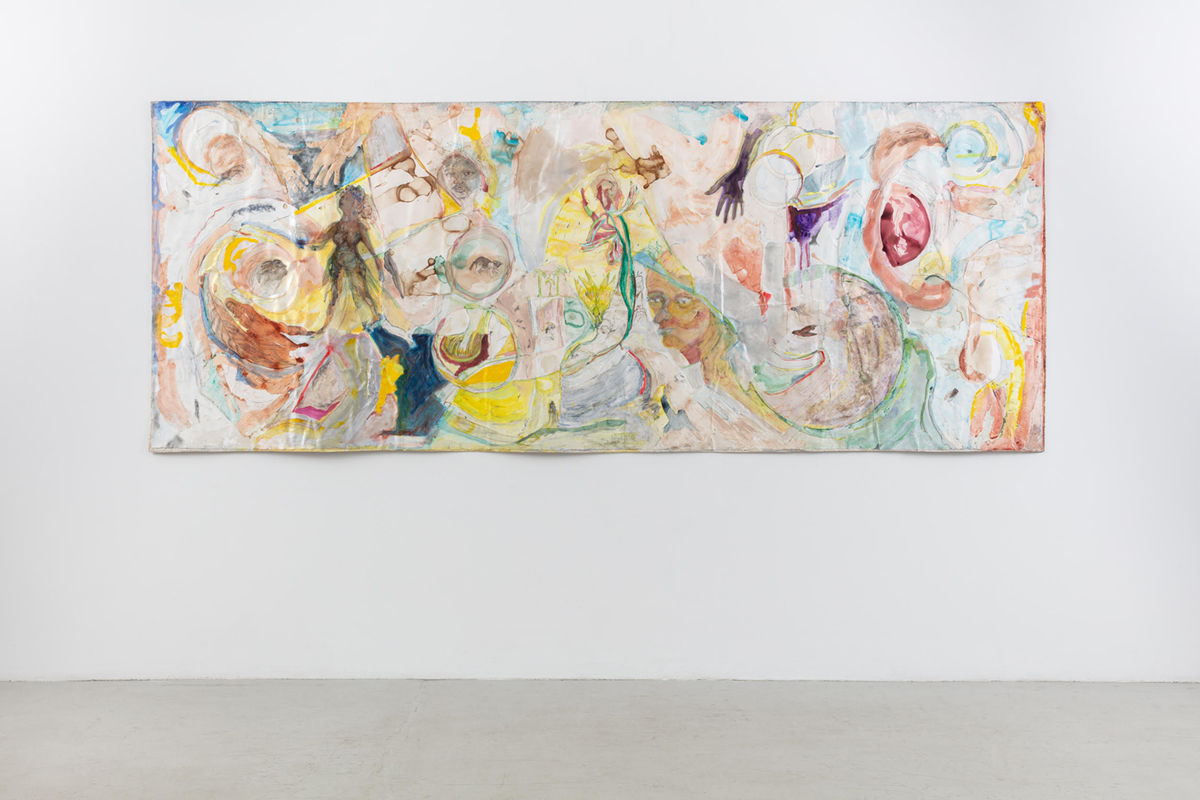
Erin: All right I want to share one of our audience questions: “Do you feel like there are stereotypes that you have to push back against as an artist working in the south?
Suzanne: I think for me not expecting to come to live in the south, I thought I would be living in New Mexico or some place in the middle of the country, my coming here I think I was confronted by the “come here’s” and “been here’s” type of people. The “come here’s” always wanted to help and uplift and help to make things better. I accidentally became president of the neighborhood association which I couldn’t believe happened to me, but I got to know the people of the community. It was really difficult to do because I was teaching at SCAD full-time as well but by participating in the community and the neighborhood, I really did get to know more about how people live and what the history is. I was able to assist Mr. Carroll Greene, an art historian and curator who lived here before he passed away, with some research I had done in the 70s that had to do with the south and never realizing I would be here in the place where that research actually came from. It was about Black African retention in the Americas. I now have an attitude about people who come here who are pushy and don’t understand the culture, as well as they should. I think that was for me missing all of the variety of languages and different kinds of people in more cosmopolitan centers but then learning the intricacies of the “two cultures that are here” in the south, Black and white, and the interplay has been quite fascinating for me.
Katya: I feel like I can speak to this just because I’m enrolled in a “northern institution” for grad school and yeah—my parents are from other countries—but I’m from Florida. I lived in New York for college and ended up having to move back to Florida. I hadn’t really realized until making the drive from Florida to New York that like, there was this chunk of place that I wanted to deal with more. Being in this northern institution, I think there’s a lot of denial and discomfort especially in what I would call white liberal space. Like confronting the totality of American history including how white supremacy is not solely located in the south. I think I was really nervous to even mention that I live in Georgia when all of my peers were New York based. But I sort of feel like the reality check is coming for them that that’s not necessarily the best model for dealing with this country.
Yanique: When I went to graduate school and everybody else coming from progressive places like California or New York or some exotic part of the world, you feel at times really backward when you say you’re from Atlanta, Georgia. SAIC being a highly conceptual space, and experimentally ripe, I wanted to fight against that southern stereotype of innate backwardness and then of course being a Black woman who’s working primarily with the body and the figural, you know, and some people saying that’s kind of antiquated. I wanted to push back from this while simultaneously strengthening my conceptual roots. I really wanted to create a robust ideology where people couldn’t easily pigeonhole me or foreclose the kind of work I could create or limit my imaginative pull/reach, simply because I am from the south or because I’m Black or because I’m a woman.
Erin: I can definitely attest to this as someone who runs a publication and deals with so many different southern artists. I think there is this assumption of the south, particularly in past lives when I’ve dealt with so-called “folk” and self-taught art, that there’s legitimate and illegitimate training and spaces. The south complicates and builds on the fact that many things can exist at the same time. Something can be self-taught and expert, someone can be highly educated and also still figuring it out in the studio and that has been really fascinating for me to interface with artists in the region. Some artists are fine leaning into the dumb southern stereotype and love playing with the “white trash” or backwoods trope and others are articulating spaces that can exist between those black and white ideas of what is or isn’t important in the art world. I think the south is very fascinating; it’s a place where everyone is creating their own ways of being and their own ways of making.
This program was produced in partnership with KADIST, San Francisco and made possible thanks to their support.

